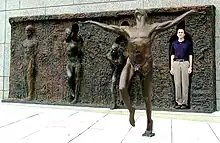 Frudakis posing with the sculpture | |
| 39°57′29″N 75°09′58″W / 39.95798°N 75.16602°W | |
| Location | Philadelphia, Pennsylvania, U.S. |
|---|---|
| Designer | Zenos Frudakis |
| Material | Bronze |
| Length | 20 ft (6.1 m) |
| Height | 8 ft (2.4 m) |
| Weight | 7,000 pounds (3,200 kg) |
| Completion date | 2000 |
| Opening date | June 18, 2001 |
| Dedicated to | All forms of freedom |
| Website | Artist's website |
Freedom is a bronze public sculpture in the form of a large slab and a freestanding statue by American sculptor Zenos Frudakis, installed in 2000 outside the offices of GlaxoSmithKline in central Philadelphia, Pennsylvania. The sculpture invites viewers to pose for a photograph in an empty cavity.
Background
The sculptor, Zenos Frudakis, wanted to create a sculpture centering around the idea of breaking free.[1][lower-alpha 1] The slab is said to represent freedom from all restrictions: mental, political, religious, and physical,[3] and has been called a "visual metaphor for the process of transformation".[4]
Design
.jpg.webp)
The sculpture, completed in 2000 and dedicated on June 18, 2001,[2] consists of a 20-by-8-foot-long (6.1 m × 2.4 m) bronze slab weighing 7,000 pounds (3,200 kg) and a freestanding bronze statue.[3] It is installed at ground level on a wall outside the Philadelphia offices of GlaxoSmithKline on Vine Street.[5]
Freedom centers around four human figures depicted in different stages of freeing themselves in the slab. The rightmost figure has broken free and stands away from the slab with outstretched arms. Frudakis left the inscription "stand here" in the cavity vacated by the figure as an invitation for viewers to pose for a photograph.[6]
Frudakis cast his own face and his sculpting tools as part of the artwork, and included depictions of twenty-five people and a cat in the bronze.[1]
Reception
Freedom has been recognized as one of the best public art sculptures.[6] Architectural Digest called it one of the "28 of the Most Fascinating Public Sculptures" in 2019.[7]
Writing in The Independent in 2021, John Rentoul ranked the sculpture fifth on his top-ten list of best public artworks.[5]
Explanatory notes
References
- 1 2 Yoo, Alice (October 4, 2011). "Sculpture Breaks Free". My Modern Met. Archived from the original on December 29, 2021. Retrieved December 29, 2021.
- 1 2 "Freedom Sculpture". Zenos Frudakis. Frudakis Studio, inc. Archived from the original on December 29, 2021. Retrieved December 29, 2021.
- 1 2 Amorosi, A.D. (February 10, 2021). "Forging Frank: Meet Zenos Frudakis, The Sculptor Behind The Rizzo Statue". Philadelphia Weekly. Archived from the original on December 29, 2021. Retrieved December 29, 2021.
- ↑ Winborn, Mark (2018). Interpretation in Jungian Analysis: Art and Technique. United Kingdom: Routledge publishing.
- 1 2 Rentoul, John (November 2, 2014). "The Top Ten: Public art". The Independent. Archived from the original on December 29, 2021. Retrieved December 29, 2021.
- 1 2 Lebeau, Mary Dixon (2018). Secret Philadelphia : a guide to the weird, wonderful, and obscure. St. Louis, MO: Ready Press. p. 28. ISBN 978-1-68106-134-4. Retrieved December 29, 2021.
- ↑ Mafi, Nick (November 22, 2019). "28 of the Most Fascinating Public Sculptures". Condé Nast. Architectural Digest. Archived from the original on December 29, 2021. Retrieved December 29, 2021.
External links
 Media related to Freedom Sculpture at Wikimedia Commons
Media related to Freedom Sculpture at Wikimedia Commons